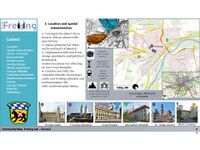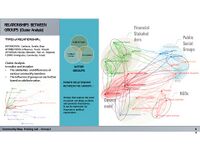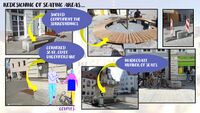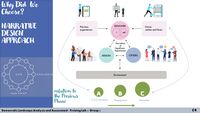LED2LEAP 2020 - Freising Team 2: Difference between revisions
| Line 299: | Line 299: | ||
== The Story of Analysis == | == The Story of Analysis == | ||
<gallery caption=" " widths="200px" heights="150px" perrow="4"> | <gallery caption=" " widths="200px" heights="150px" perrow="4"> | ||
Revision as of 07:55, 3 June 2020
>>>back to working groups overview
Landscape Democracy Rationale
- Why do you think this community context is relevant from a landscape democracy perspective? What is your hypothesis considering the landscape democracy challenges?
We believe that we can solve the problems in question in order to Democratic landscape perspective in Freising.
It means that there is capacity to see the broad picture on Integrated actions at the landscape scale in Freising which allow groups to evolve dynamically.
ASSUMPTIONS:
All communities and Voices are equel.
Individuels have the ability to make changes.
Every group has its own values.
Location and scope
- The Location is located in Freising.
- Our main focus area is the old town of Freising.
Phase A: Mapping your Community
Groups of actors and stakeholders in your community
- Which groups/sub-communities are there? What are their needs and aspirations with regard to the landscape? Which groups are more visible? Which are less visible? What do we not know?
SOCIAL GROUPS:
- political actors (Political parties, politicians )
- NGOs ( Environmental “German Environmental Aid Association”, social ”Caritas”, health “Gesundheitszentrum Kneippgarten”, Human rights … ) ( Non-profitable )
- public groups ( elderly, parent students, , single parents, adolescents ,International students, )
- Brands’ customers ( Apple, Adidas, Nike, ..etc )
- competitors ( sports clubs )
Needs
Income Increase
+
Social Connections
+
Better connection to public transportation
+
Housing Facilities
Aspirations
Better life conditions
+
Be more involved in Society
+
Financial support
+
Social Support
+
connection with other single parents
+
More Job opportunities
+
Increase the number of bus stations
+
Easier renting process
_________________________________________________________________________________________________________________________________
LOCAL STAKEHOLDERS:
- Retailers
- Breweries
- Associations ( City Marketing Association, Inner city management Association,City Economic Development Agency,.... etc)
- Religious Organizations
- Profitable Organizations.
Needs
Investment
+
Financial Stability
Aspirations
More Income
+
More Effective role in life quality Development
+
Growing business with higher profits
+
More social Impact on people’s lives
_________________________________________________________________________________________________________________________________
*EXTERNAL STAKEHOLDERS:
- Financial stakeholders: (Banks, Shareholders, Insurance Companies, Construction Companies)
- Governmental Groups: (National Authorities ( Mayor, City Council, ... etc), Government offices, Education System, Health System)
Needs
social support
Aspirations
More development for both economical and social sector
+
Better life and health for all citizens
+
Better education system
Relationships between your actors and groups
- How would you describe the power relationship between the groups?
the external groups and Finantial Stakeholders express the need for power to do so direct and promote themselves. It is expressed by financial or political expressions .
- Which groups may have shared interests and which are these?
Social Groups and and Education system express have similarities in various members.
NGOs and Government have some Influences of social groups on each other based on attribute value.
TYPES of RELATIONSHIPs:
- INTERACTION: Contacts, Emails, Buys
- ATTRIBUTIONS: Influences, Trusts, Friends
- AFFILITIAN: Similar, Member, Part of, Depends
- FLOWS: Immigrates, Commutes, Feeds
SHARED INTERESTS:
- common objectives
- common goals
- well-integrated manner
POWER RELATIONSHIP :
- Authority
- Leadership
- control tend to be preferred
CONFLICTS
It exists as a latent rather than manifest characteristic of society. A conflict of interest or power is a situation in which a person or organization is involved in multiple interests, financial or otherwise, and serving one interest could involve working against another. Typically, this relates to situations in which the personal interest of an individual or organization might adversely affect a duty owed to make decisions for the benefit of a third party.
Summary of your learnings from the transnational discussion panel on April 22
On April 22 you will present the PPT version of this first assignment to other seminar groups working in other geographical community contexts.
- Cluster Analysis:
to realize and visualize:
The similarities and differences of various community members
The Influence of groups on each other based on attribute value.
- POWER, CONFLICTS, INTERESTS MATRIX
Theory reflection
We have seen so far that ‘democracy’ is a complex concept including at least three different sets of values drawing in different directions. Self-determination focuses on the promotion of free scope for autonomous individuals. Codetermination demands equal consideration or access to infuence on common decisions. Respect for argument stresses the need to justify wishes and requests with reasons one expects to be acceptable to all. The frst part of the Demorcy is the quest for democracy, followed by various methods that may be applied in order to make landscape decisions more democratic. We used this Method as a means of involving stakeholders in the democratic process of defning goals and objectives in local landscapes.
References
- https://www.ukessays.com/essays/education/stakeholders-into-primary-and-secondary.php
- https://subjecto.com/stakeholders-mapping-and-power-interest-matrix
- Juliane Schütt, Katharina Löhr, Michelle Bonatti and Stefan Sieber, Conflict Causes and Prevention Strategies at the Society-Science Nexus in Transdisciplinary Collaborative Research Settings: A Case Study of a Food Security Project in Tanzania, Sustainability, 10.3390/su11226239, 11, 22, (6239), (2019).
- Moura, H.M. and Teixeira, J.C. (2010). Managing Stakeholders Conflicts. In Construction Stakeholder Management (eds E. Chinyio and P. Olomolaiye). doi:10.1002/9781444315349.ch17
- https://www.bayer.com/en/stakeholder-dialogue.aspx
- https://www.hier-sind-die-fakten.de/de/aktueller-stand-zu-den-stakeholder-listen-von-monsanto.aspx
Phase B: Democratic Landscape Analysis and Assessment
The Scene in your Story of Analysis
1- Landscape democracy challenge :
Lack of green spaces and recreational areas in Altstadt of Freising
lively historic center of the cathedral city between Domberg and Weihenstephaner Berg.
This layout of Altstadt from 1159 has been largely preserved to this day.
2- Description of the physical historical scene :
1- The center of this historical story started while Domberg was officially confirmed as a bishopric in 739 AD, in the 9th and 10th centuries the civil town at the foot of the Domberg gradually emerged as a suburbium.
2- The most popular square in Freising is Marienplatz where all city festivals are celebrated with the highly visible Marian column from 1674.
3- The colored building’s facades with detailed decorations of Gothic and Baroque palaces along the old town streets.
4-At Marienplatz is located the baroque Asam museum, the former prince-bishop's college.
5- Rathaus in Marienplatz was built in 1904 in the style of old German official buildings from the late Middle Ages and the Renaissance.
6- Behind Rathaus it is located Gothic St. Georg church.Its tower go up the 84 meters and it is considered one of the most beautiful baroque towers in old Bavaria.
3- Socio-economic and political characteristics :
1- Marienplatz is considered a very popular meeting place for locals and guests in Freising.
2- Along the Altstadt streets there are beautiful boutiques, shops, cafés and restaurants with a length of around 960 meter on the main street.
3- In the Altstadt is located 8 different bank branches in one old street.
4- Contextual elements
1- Historical background
2- Marinplatz & Rathaus
3- Domberg
4- St. Georg church
5- Shops & Restaurants
6- Banks
7- Gothic and Baroque building’s facades
The Actors in your Story of Analysis
- Describe the characters and their role in the story. Are they major or minor characters? Are there any key relationships that need to be defined?
- add the corresponding visual from your presentation to the image gallery below
Stakeholder and key actors
Women & Girls
Couples
Famlies
Teenagers
Students
Roles of Actors
Secondary Character
Main Character
Flat Character
Their Acts
Dynamic
changing
Static
unchanging
Stock
</gallery>
The Story of Analysis
Reflect on your Story of Analysis
- How did the tools you chose for landscape analysis fit your community? Reflect on the questions: What did you carry? Why did you carry? How did you carry? What remains after you've left? (150 words)
- add the corresponding visual from your presentation to the image gallery below
Phase C: Collaborative Visioning and Goal Setting
* template coming
Phase D: Collaborative Design, Transformation and Planning
* template coming
Phase E: Collaborative Design, Transformation and Planning
* template coming
= Phase E: Collaborative Evaluation and Future Agendas * template coming
Process Reflection
- Reflect in your intercultural and interdisciplinary team on the outcomes of your study
- Which limitations were you facing?
- What have you learnt from each other?
- What would you do differently next time?
- You can also use diagrams/visuals
- 250 words text





















